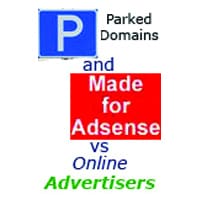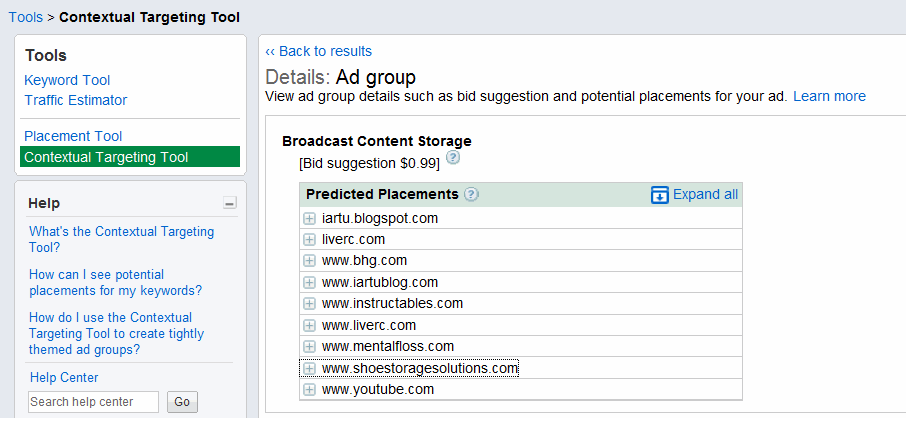Many Google Adwords advertisers have improved their Adwords ROI using Google’s Display Network because it allows them to extend their advertising reach and target prospects on contextually relevant websites that display Google ads. However, the contextual targeting has always been far from perfect and advertisers are often shocked to discover their ads appearing on non-contextually related web pages, parked domains and low quality sites. By “low quality sites” we mean MFA or Made-For-AdSense sites where the sole purpose is for the website owner to get a portion of the cost per click the Google advertiser pays. The more clicks, the more money they make. As you can imagine, the quality of traffic from sites like this is poor.
On the other hand, if a Display Network campaign is setup properly and with on-going optimization and vigilant blocking of poor quality sites, it can be quite profitable for the advertiser. Some of our clients have received more leads, at a lower cost per lead, from the Display Network than from Search.
In order for Display Network to be effective, you have to make sure your ads only appear on contextually relevant sites and exclude parked domains using Google’s Site and Category exclusion tool. The most straightforward way is by targeting individual sites under Managed Placements, which involves hand-picking each site you want your ads to appear on. It’s very precise, though you do pay more per click. However, many sites do not opt in to Placement Targeting, so you miss exposure on a lot of potentially good sites.
Until recently, Google allowed advertisers to pre-select Categories like Home & Garden or Automotive under Managed Placements. We used this Category targeting approach in Managed Placements extensively for our clients because it was a good way to benefit from lower Cost-Per-Click and wider reach, while still restricting ads to relevant websites. We usually avoided Automatic Placements, where Google chooses sites to display your ads based on one or more keywords that you provide, because that always resulted in paid clicks from low quality sites as well as sites that were contextually unrelated to our ad.
In February, Google disabled Category targeting and replaced it with Topics. At first blush, Topics seemed similar to Categories, although it is accessed through Automatic Placements rather than Managed Placements. Automatic Placements uses keywords to help Google select sites that are relevant to your ads — at least in theory. In practice, with Topics we’ve seen contextual relevance ranging from poor to abysmal and ads appearing on MFA (Made For Adsense) sites of the lowest quality.
When we spoke with a Google Display Network specialist about this problem, they recommended we use the Contextual Targeting Tool to help target sites. Below is an example of what this tool provides. In this example, we are targeting a very specific type of need, trying to place ads for an attached storage solution for broadcast video content, something a TV station, news or sports channel might use to store and retrieve video clips. This worked very well with Category Targeting. We entered the keyword “broadcast content storage,” clicked on the recommended AdGroup, and it came back with a list of sites:
iartu.blogspot.com – a blog site containing photos of indoor and outdoor scenes in Seattle along with some AdWords ads.
liverc.com – a site apparently for enthusiasts of radio controlled toy cars
Bhg.com – the online version of the magazine Better Homes and Gardens
www.iartublog.com – redirects to iartu.blogspot.com (mentioned above)
www.instructables.com – a website full of every imaginable how-to guide
www.mentalfloss.com – online version of magazine Mental Floss. Tagline: Where Knowledge Junkies Get Their Fix
www.shoestoragesolutions.com – just what you’d expect on a site with that URL
www.youtube.com – needs no explanation
Observations and Conclusions:
- Google eliminated Category Targeting, replacing it with Topics Targeting, forcing advertisers to move their ads into a separate campaign and choose the “Relevant pages across the entire network” option under “Networks and Devices” in the campaign settings. This enables more content sites across all categories (not just the ones the advertiser picked) to display ads.
- The percentage of MFA sites in the ad rotation for automatic placement seems to have increased. Whether that’s because there are simply more of this type of site or because Google makes it harder to pre-filter them, more clicks from MFA sites means more money wasted.
- Google makes it hard even to block bad sites individually. The Placement Performance Report does not list sites that are showing your ads, only those where you have already paid for clicks, so there’s no way to proactively weed out bad sites. What’s worse, some of those sites you’ve paid for show up in the Placement Performance Report as “RandomNumber.anonymous.google.” Don’t advertisers have the right to know where their paid clicks are coming from?
- Advertisers who want managed placements only, and thus avoid paying for junk clicks, pay substantially more per click.
The result for advertisers: higher costs, less quality and decreased precision of targeting.




